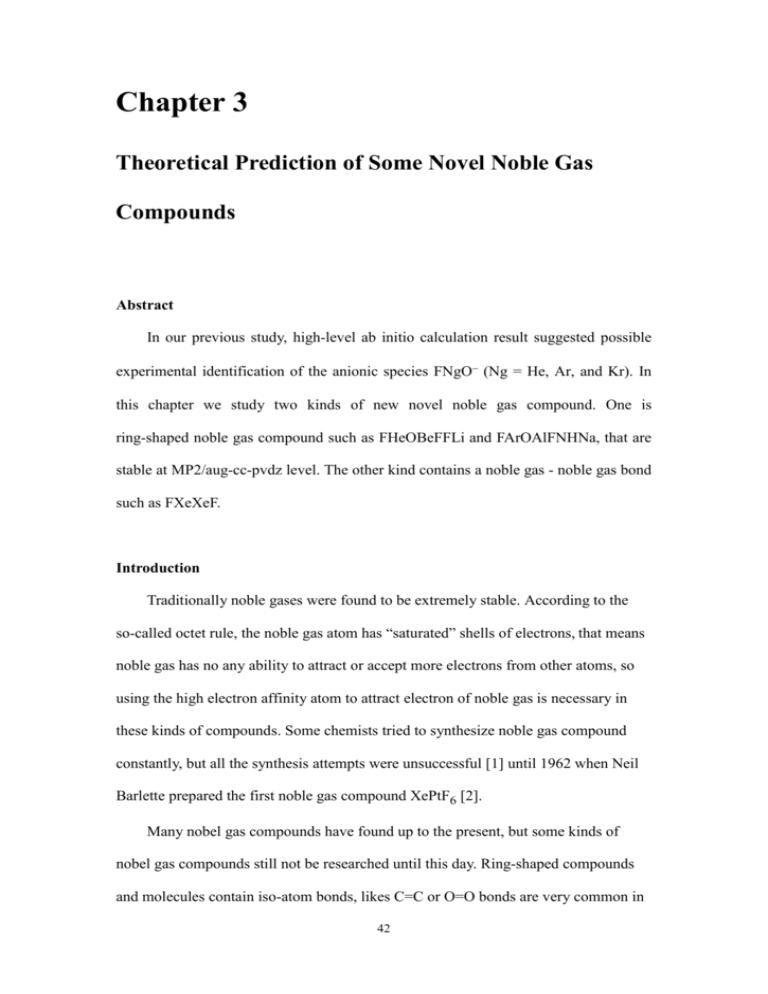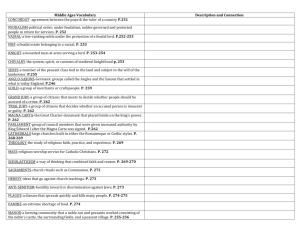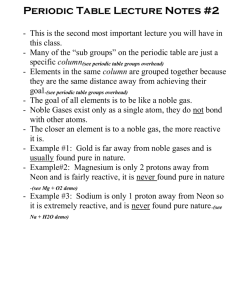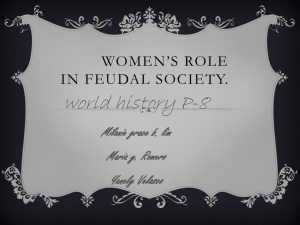Cyclic noble gas compound
advertisement

Chapter 3 Theoretical Prediction of Some Novel Noble Gas Compounds Abstract In our previous study, high-level ab initio calculation result suggested possible experimental identification of the anionic species FNgO (Ng = He, Ar, and Kr). In this chapter we study two kinds of new novel noble gas compound. One is ring-shaped noble gas compound such as FHeOBeFFLi and FArOAlFNHNa, that are stable at MP2/aug-cc-pvdz level. The other kind contains a noble gas - noble gas bond such as FXeXeF. Introduction Traditionally noble gases were found to be extremely stable. According to the so-called octet rule, the noble gas atom has “saturated” shells of electrons, that means noble gas has no any ability to attract or accept more electrons from other atoms, so using the high electron affinity atom to attract electron of noble gas is necessary in these kinds of compounds. Some chemists tried to synthesize noble gas compound constantly, but all the synthesis attempts were unsuccessful [1] until 1962 when Neil Barlette prepared the first noble gas compound XePtF6 [2]. Many nobel gas compounds have found up to the present, but some kinds of nobel gas compounds still not be researched until this day. Ring-shaped compounds and molecules contain iso-atom bonds, likes C=C or O=O bonds are very common in 42 general molecules, but noble gas is very special, ring-shaped noble gas compounds and noble gas - noble gas compounds were still not found. The most common noble gas compound is HNgY type, such as HArF [3], HKrF [5] or FKrF, the FKrF molecule have been experimentally identified [5]. Almost all of noble gas compounds are including fluorine, because fluorine has highest electron affinity of whole element. But electron configuration of fluorine is 1s22s22p5, that means it is single-covalent, we can’t bond any other atoms with fluorine after it bonded with noble gas. For this reason, almost all noble gas compounds are linear, and ring-shaped noble gas compounds are difficult to form. In previous study [6] of our laboratory, we have noticed that the FNgO ions (Ng = He, Ar, Kr) have very compact structures and singlet ground states with large singlettriplet gaps. Therefore, our technique is using oxygen to substitute one fluorine atom in FNgF, and bond another metal atom with oxygen. Because the oxygen - noble gas bond and oxygen – metal bond are single bonds, and the hybrid orbital of oxygen is sp3, the shape of this noble gas compound is no longer linear. In the side of fluorine, we also used metal atoms to connect it. Although it won't form a covalent bond, but they has very strong electrostatic interaction, thus we can used some fragments contain metal atomsfor a ring shaped molecule. Because electronic configuration of the noble gas is full, a noble gas won’t bond with another noble gas, so there are no diatomic molecules of noble gas. We tried to using fluorine bonding with noble gas atom. Fluorine will attract electrons on noble gas and make it electron-poor. Therefore, the noble gas has ability to bond with another noble gas, like FXeXeF. And some other little molecules we also added around it, tried to make it more stable. In this chapter we founded some ring-shaped noble gas compounds and noble 43 gas – noble gas compounds. We will discuss their stability by different quantum chemical calculation level. Method Møller-Plesset second-order perturbation theory (MP2) [7] and the coupled-cluster method CCSD(T) [8] were applied with Pople type basis sets [9-11] and Dunning’s augmented correlation consistent basis sets (aug-cc-pVnZ, n = D, T, Q) [12-15] to calculate the structures and energies. The electronic structure calculation was performed using the Gaussian 03 program [16]. Results and Discussion Ring-shaped noble gas compounds: helium compounds Recently, we found a ring-shaped noble gas compound FHeOBFOLi. Helium binds with a fluorine atom and an oxygen atom, and oxygen atom linked a boron atom on the other side. Around FHeOB, an oxygen - lithium group and another flourine atom also linked to boron. The shape of this compound is plane and it looks like a ring, shows as Figure 1. In MP2/aug-cc-pVDZ level, the oxygen – helium bond length is 1.09 angstrom, and fluorine – helium bond length is 1.44 angstrom. The angle of oxygen – helium – fluorine is 173 degree, it’s almost linear. This compound has two decomposition ways. One is the motion of oxygen to insert into B-F bond, and He-F will go away from the ring, this process should cross a barrier, we called it bending barrier (Figure 2). Another is the breaking of F-Li electrostatic interaction, lithium will catch another fluorine atom which binding on the boron, this process should cross a barrier too, we called it breaking barrier (Figure 3). Two ways are all cause the scattering of this ring. In MP2/aug-cc-pVDZ level, two 44 decomposition barriers are 10.32 and 15.95 kcal/mol respectively. Two decomposition barriers and the calculations of different levels are summarized in Table 1. Figure 1 The structure of FHeOBFOLi Table 1 Two barriers of different levels of FHeOBFOLi in kcal/mol. MP2/6-31+G(d,p) MP2/aug-cc-pvDZ CCSD(T)/aug-cc-pVTZ SPa bending barrier 13.94 15.95 10.97 breaking barrier 8.98 10.32 10.10 a CCSD(T)/aug-cc-pvTZ single point energy with MP2/aug-cc-pvDZ structure. 45 Figure 2 Bending motion Figure 3 Breaking motion 46 By substitution of fluorine, lithium or boron, we tested many similar compounds including FHeOAlFOLi, FHeOBFONa, FHeOBOHOLi, FHeOBOHONa and FHeOBClOLi. All of these rings have the same decomposition ways. However, the stability of these compounds are less than FHeOBFOLi. We compared two barriers of these compounds with MP2/6-31+G(d,p) level, results are list in Table 2. Table 2 Comparison of two barriers of six similar compounds with MP2/6-31+G(d,p) in kcal/mol. bending barrier breaking barrier FHeOBFOLi 13.94 8.98 FHeOAlFOLi 7.69 11.57 FHeOBFONa 19.16 5.14 FHeOBOHOLi 8.73 11.93 FHeOBOHONa 11.15 7.84 FHeOBClOLi 1.96 7.05 If we substitution boron by aluminum in FHeOBFOLi, breaking barrier will increase 2.5 kcal/mol, but bending barrier will decrease about 6.3 kcal/mol. However, the substitution of lithium by sodium got the reverse result, which will cause of bending barrier increasing and breaking barrier decreasing. By the testing of all combinations, we found bending way and breaking way are competing, so increasing two barriers at the same time is very difficult. Some other ring-shaped noble gas compounds we also investigated, such as FHeOBeFFLi (Figure 4) and FHeOSiF2OLi (Figure 5). The decomposition ways of these two rings are similar with FHeOBFOLi, except a particular difference in FHeOSiF2OLi. Fluorine binding with helium will attack silicon by bending way in the FHeOSiF2OLi ring. Summary of these compounds are list in Table 3 and Table 4. 47 Figure 4 The structure of FHeOBeFFLi Figure 5 The structure of FHeOSiF2OLi 48 Table 3 Comparison of bending barriers of three cyclic noble gas compounds in kcal/mol MP2/6-31+G(d,p) MP2/aug-cc-pvDZ CCSD(T)/aug-cc-pvTZ SPa a FHeOBFOLi 13.94 15.95 10.97 FHeOBeFFLi 8.54 10.77 6.72 FHeOSiF2OLi 12.33 10.23 - CCSD(T)/aug-cc-pvTZ single point energy with MP2/aug-cc-pvDZ structure. Table 4 Comparison of breaking barriers of three cyclic noble gas compounds in kcal/mol breaking barrier MP2/6-31+G(d,p) MP2/aug-cc-pvDZ CCSD(T)/aug-cc-pvTZ SPa a FHeOBFOLi 8.98 10.32 10.10 FHeOBeFFLi 34.80 26.70 27.39 FHeOSiF2OLi 5.57 8.20 - CCSD(T)/aug-cc-pvTZ single point energy with MP2/aug-cc-pvDZ structure. With the substitution of boron by beryllium, the bending barrier high was decrease, but breaking barrier high increase largely. However, the minimum barrier high is not the breaking barrier high, so this substitution does not increase the stability. Although these compounds seem to be stable in MP2 calculation, there is a serious problem. In high level CCSD(T)/aug-cc-pVDZ optimization calculations, we can’t find their stable structures. For the FHeOBFOLi compound, it seems to first decompose to FHe and OBFLi, and then to fluorine and helium atoms. So the stability of these rings still needs farther investigation. 49 Ring-shaped noble gas compounds: argon compounds In argon rings, we replaced some atoms in helium rings by second-row elements. The first stable ring we found is FArOAlFNHNa (Figure 6). The shape of it is also planar, it has three decomposition barriers at least 11 kcal/mol at the MP2/aug-cc-pvDZ level. Three decomposition ways are the king of F-Na electrostatic interaction, distortion of ring when fluorine attacks to aluminum and oxygen inert into Al-F bond. These processes will undergo some barriers, we called them breaking barrier, F-Al bending barrier, oxygen bending barrier, respectively. Three barriers calculation on different levels of FArOAlFNHNa are list in Table 5. Figure 6 The structure of FArOAlFNHNa 50 Table 5 Three barriers of different levels of FArOAlFNHNa in kcal/mol. MP2/6-31+G(d,p) MP2/aug-cc-pvDZ CCSD(T)/aug-cc-pvTZ SPa breaking barrier 17.04 17.13 12.67 F-Al bending barrier 14.35 16.32 17.11 11.63 11.66 15.30 oxygen bending barrier a CCSD(T)/aug-cc-pvTZ single point energy with MP2/aug-cc-pvDZ structure. Similar rings FArOBFOLi (Figure 7) and FArOBeFFNa (Figure 8) are also stable at MP2/aug-cc-pvDZ level, but we can’t find their F-B or F-Be bending barriers. Comparison of calculated barriers of these rings at MP2/aug-cc-pVDZ level is list in Table 6. Figure 7 The structure of FArOBFOLi 51 Figure 8 The structure of FArOBeFFNa Table 6 Comparison of two barriers of two similar compounds with MP2/aug-cc-pvDZ in kcal/mol. bending barrier breaking barrier FArOBFOLi 13.07 7.34 FArOBeFFNa 12.39 19.85 However, as helium rings, in high level CCSD(T) optimization calculations, we can’t find its stable structure, so the stability of argon rings should be deliberated too. 52 Noble gas - noble gas compounds With CCSD(T)/aug-cc-pVTZ level, the bond length of I2 is 2.69 angstrom, almost agree with experimental value [17]. However, the same period Xe atom has 4.35 angstrom length between Xe-Xe with the same level. It is not a “bond”, there is only very weak van der waal interaction between Xe atoms. So we tried to using some high electron affinity atoms to make it stable. The first noble gas – noble gas compound we found is FXeXeF. By electron density map (figure 9), we can confirmed there is a covalent bond between two xenon atoms. With high level calculation, the structure of FXeXeF is credible. Xe-Xe bond length is 3.02 angstrom by CCSD(T)/aug-cc-pVDZ optimization calculation. Figure 9 Electron density map of FXeXeF with MP2/aug-cc-pvDZ level. FXeXeF has three decomposition ways, the linear decomposition to fluorine and xenon atoms is the basic way, the relative energy of FXeXeF to its individual atoms is -10.2 kcal/mol. Another decomposition way is the bending decomposition. FXeXeF 53 will decompose to xenon atom and FXeF, but the barrier of this reaction is very high, about 46.4 kcal/mol with MP2/aug-cc-pvDZ level. In MP2/aug-cc-pvDZ level, FXe does not exist; but we can performed optimization and got its structure when we changed basis set to aug-cc-pvTZ. So there is a third decomposition way that FXeXeF decomposed to two FXe fragments, the relative energy of FXeXeF to two FXe fragments is only -3.8 kcal/mol in CCSD(T)/aug-cc-pvTZ level. Because of the decomposition of FXeXeF from Xe-Xe bond is very easy, we tried to add something around it to increase its stability. We started with some metal halides like LiF or NaF, but it has a serious problem that the fluorine atom from metal halides will attack the far noble gas and form F-Xe-F. Although this processes should undergo a barrier but it is not very high. For example, In FXeXeFLiF molecule, this barrier is only 3.5 kcal/mol with MP2/aug-cc-pVDZ level. With many attempt, most effective molecule of our testing is HF, the complex compound FXeXeF-HF is shown as figure 10. We also tried to added two HF molecules on the both sides of FXeXeF; nevertheless, the result is similar with one HF added. 54 Figure 10 The structure of FXeXeF-HF In MP2/aug-cc-pVDZ level, the bond length of Xe-Xe in FXeXeF-HF also shorten to 3.05 angstrom, compare with 3.12 angstrom which in FXeXeF. The bending barrier of FXeXeF-HF was less than FXeXeF, but still remained 18.91 kcal/mol with MP2/aug-cc-pvDZ level. However, the relative energy of decomposition from Xe-Xe bond was increase slightly. Because of the limitation of our calculation ability, we can’t performed CCSD(T)/aug-cc-pvTZ optimization of FXeXeF-HF, but we can performed the fragment XeF-HF, so we confirmed the relative energy of decomposition from Xe-Xe of FXeXeF-HF is -7.46 kcal/mol at least. Conclusion Although we found some helium and argon rings existed with MP2/aug-cc-pvDZ level, but we still can’t found the stable structure using CCSD(T) method. This may cause of the calculation type of CCSD(T) or our calculation ability. So the existence of cyclic noble gas compound is not clear at present. However, we got very important progress in noble gas – noble gas compound, although FXeXeF-HF may only exist in very low temperature, but it’s the first time in the history of noble gas science, we 55 found that a noble gas atom might be able to bond with another noble gas atom. Acknowledgements This work is supported by the National Science Council of Taiwan, grant number NSC 95-2113-M-194-007. We are grateful to Mr. Chen-Chang Wu for optimizing the Gaussian 03 code, and to the National Center for High-Performance Computing (NCHC) for providing part of computation resources. 56 Reference [1] P. Laszlo, G. J. Schrobilgen, Angew. Chem., Int. Ed. Engl. 27 (1988) 479. [2] N. Bartlett, Proc. Chem. Soc. 218 (1962). [3] L. Khriachtchev, M. Pettersson, N. Runeberg, J. Lundell, M. Rasanen, Nature 406 (2000) 874. [4] M. Pettersson, L. Khriachtchev, A. Lignell, M. Ra¨sa¨nen, J. Chem. Phys. 116 (2002) 2508. [5] N. N. Greenwood, A. Earnshaw, In Chemistry of the Elements; Butterworth-Heinemann: Oxford. (2001) 888. [6] T.-H. Li, C.-H. Mou, H.-R. Chen, W.-P. Hu, J. Am. Chem. Soc. 127 (2005) 9241. [7] C. Møller, M. S. Plesset, Phys. ReV. 46 (1934) 618. [8] K. Raghavachari, G. W. Trucks, J. A. Pople, M. Head-Gordon, Chem. Phys. Lett. 157 (1989) 479. [9] P.C. Hariharan; J.A. Pople, Theoret. Chimica Acta. 28 (1973) 213. [10] M.M. Francl; W.J. Petro; W.J. Hehre; J.S. Binkley; M.S. Gordon; D.J. DeFrees; J.A. Pople, J. Chem. Phys. 77 (1982) 3654. [11] V.A. Rassolov; J.A. Pople; M.A. Ratner; T.L. Windus, J. Chem. Phys. 109 (1998) 1223. [12] T. H. Dunning, Jr., J. Chem. Phys. 90 (1989) 1007. [13] R. A. Kendall, T. H. Dunning, Jr., J. Chem. Phys. 96 (1992) 6796. [14] D. E. Woon, T. H. Dunning, Jr., J. Chem. Phys. 98 (1993) 1358. [15] A. K. Wilson, D. E. Woon, K. A. Peterson, T. H. Dunning, Jr., J. Chem. Phys. 110 (1999) 7667. [16] M.J. Frisch et al., GAUSSIAN 03, Revision D.02, Gaussian, Inc., Wallingford CT, 2004. [17] R. J. Leroy, J. Chem. Phys. 52 (1970) 2683. 57









